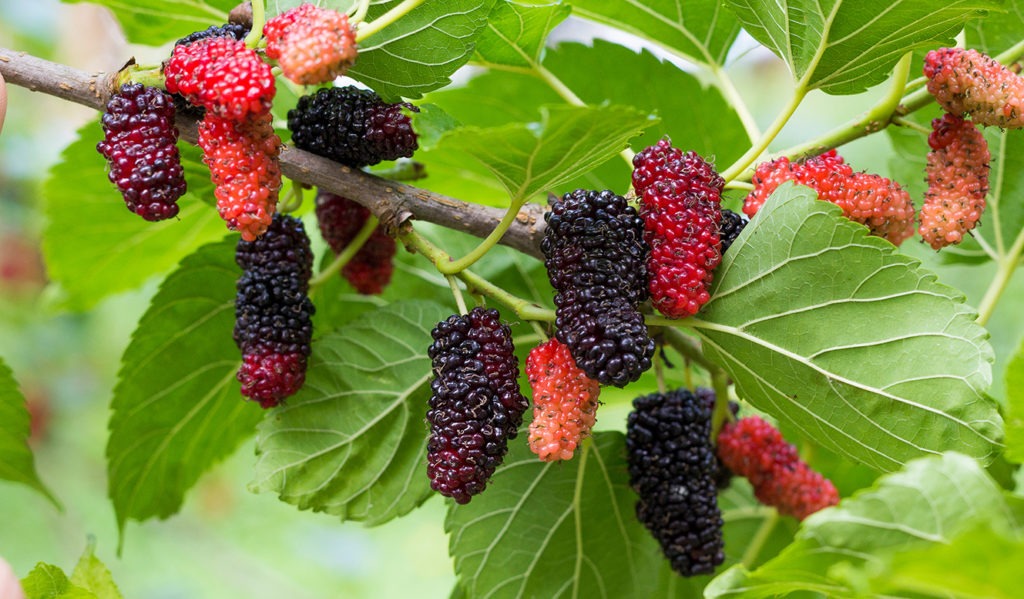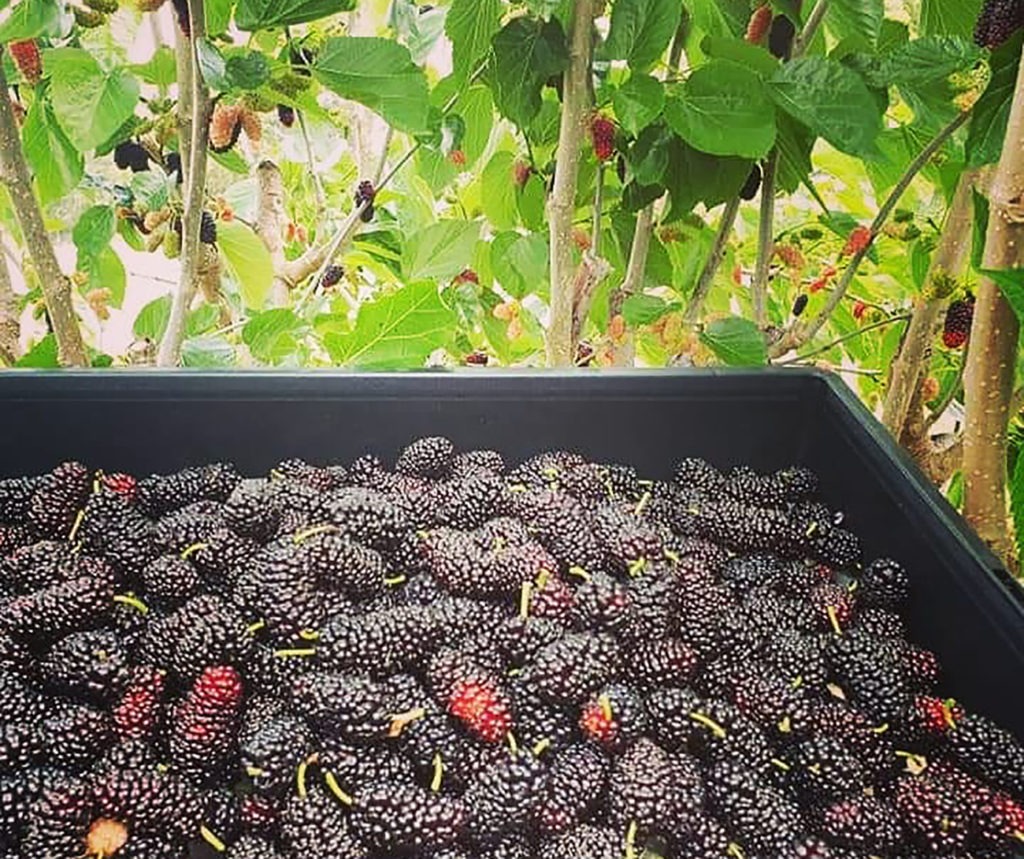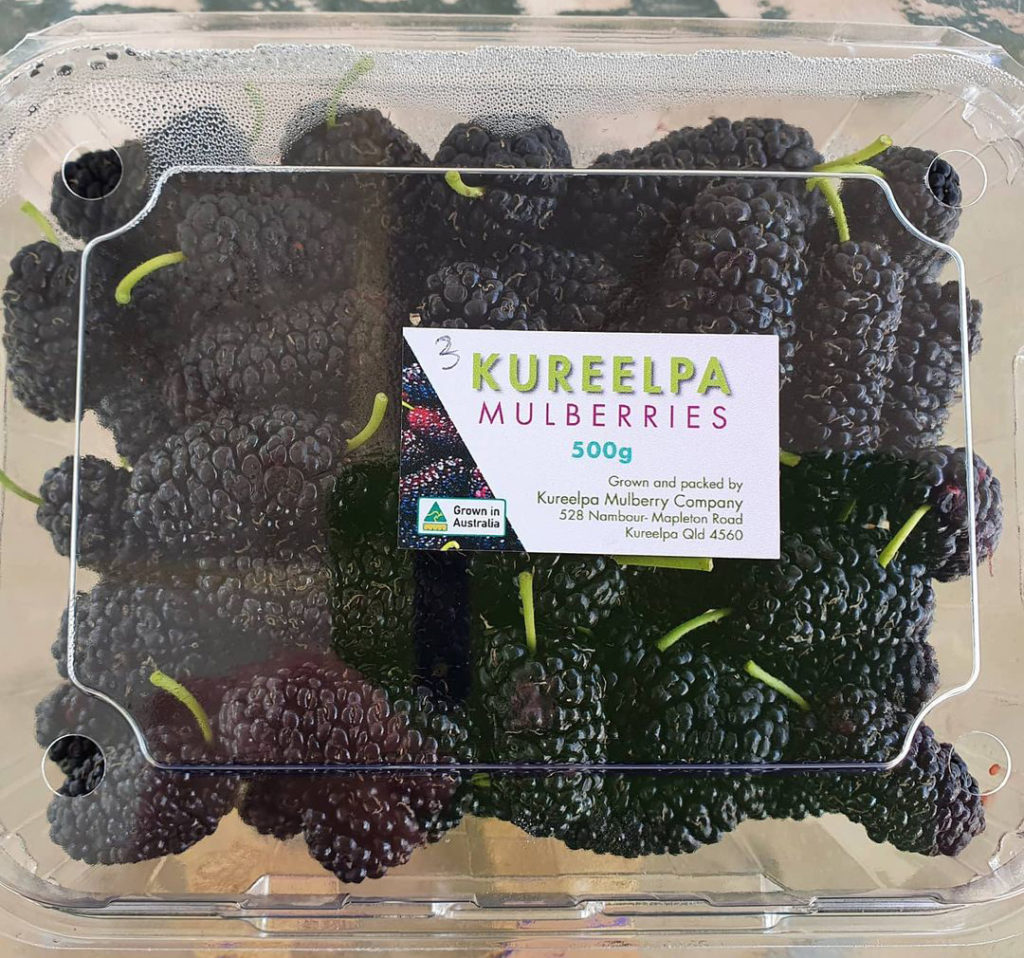Mulberries: the forgotten fruit
For many Australian adults, the local neighbourhood mulberry tree was a fond fixture of their childhood. Mere mention of the fruit can conjure up happy memories of picking and eating the sweet berries from towering branches. The leaves were plucked to feed pet silkworms kept in shoeboxes, and purple-stained hands and clothing would be testament to many an after-school mulberry fight. But for a fruit that holds such nostalgia for so many, you’re unlikely to find mulberries for sale anywhere. However, a handful of growers across Australia are now bringing back this forgotten fruit for future generations to enjoy.

Up for the challenge
While the mulberry tree itself is surprisingly hardy, producing the fruit in large quantities is tricky. Mulberries are prone to grey mould – a fungus that affects berries – and have a very short shelf life when sold in a standard punnet. It’s for this reason that mulberries are not commercially produced on a large scale in Australia, unlike other popular berry varieties.
But viticulturalist Peter Szabo decided he was up for the challenge, and began growing mulberries at his farm in Kingston on Murray in South Australia’s Riverland region in 2015.
“We had a single big mulberry tree behind the house,” Szabo says. “We decided to pick and sell the fruit to save up money for a holiday. So we picked this big tree, and we sent the mulberries in punnets off to market. For the first year, this worked really well.
“It was a very dry year; it’s normally really dry here. So it’s great for grape growing, great for growing mulberries. But the second year, we had a wet year, and we could not keep the grey mould out of the punnets, as much as we tried.”

Try and try again
While he admits he was “devastated” by his second attempt, Szabo was not to be deterred. He decided to think beyond the punnet, and instead produce mulberries to sell as a commercial product for food and beverage manufacturers.
“My background is in viticulture, and viticulture in our warm inland region is all mechanical – mechanical harvesting, mechanical pruning. Everything’s mechanical. So I took a good hard look at the tree and worked out its morphology and how it grows and then designed a trellising system, a pruning system and a harvesting system.”
Szabo now has four hectares of mulberry trees, which he trellises and prunes to allow his harvester to reach the fruit. While there was much trial and error along the way, his system is now effective enough to produce 20 tonnes of mulberries, which he sells through his business, Nockburra Creek Farms. He expects that next season, it will reach 50 tonnes.
“All I do is I emulate a good strong breeze with the grape harvester,” he explains. “So I’m basically shaking the mulberries off when they’re ripe enough.”
While the harvested fruit isn’t undamaged enough to be sold in a punnet, it’s still in perfectly good condition. Szabo and a small team pack the berries and snap-freeze them. They’re then sold to juice manufacturers, jam makers, winemakers, even gin distilleries.
“Kangaroo Island Spirits make a very nice mulberry gin from my fruit,” Szabo says. “It’s fantastic with a bit of ginger beer and mint.”

Tree change
Queensland dentist Peter Lynch had a backyard mulberry tree where he was growing up in Nambour on the Sunshine Coast, and he and his family would often enjoy eating them.
“We used to go and pick a whole pile and we would usually stew them,” he recalls. “Our favourite dessert was stewed mulberries with cream and rice bubbles. I haven’t found too many people who used to do that. But that was our own little family favourite.”
His decision to start producing mulberries began rather spontaneously five years ago, when he arrived home from work one day and noticed his mulberry tree was heavy with fruit.
“I went and ate a few and I thought, ‘These things are really nice’,” he says. “I wondered why you never see them in the shops because they’re so easy to grow. Up here, anyway.
“I knew their shelf life wouldn’t be very good. But I felt like nobody had ever really tried.”

Ready for take-off
Lynch began researching mulberries, and after a few years, he and his wife purchased a 40-acre property in South East Queensland’s Blackall Range, starting the Kureelpa Mulberry Company. To build his 1800-tree mulberry orchard, he propagated cuttings from his backyard tree, as well as cuttings from other people’s backyard trees.
“I don’t know anything about horticulture or propagating,” he admits. “But I managed to propagate them all myself. I was expecting that we might be waiting five or more years before we started to get a decent crop. But they just took off.”
The two producers have been equally amazed at how quickly their mulberry trees have grown. While there are thousands of mulberry tree varieties found worldwide, both Szabo and Lynch have a fast-growing variety known as Hicks Fancy.
“On my first year, I was thinking I was being a good person, a good viticulturist, and powered on some fertiliser, powered on some water,” Szabo says. “They just grew like mad. I had to go through and prune them again because they just went so nuts.”
After picking finishes each season – which runs from early September to late October – at the Lynch’s mulberry farm, they prune the trees back until they reach about neck height. By the following year, the trees have almost reached up to the five-metre-high netting that Lynch installed to keep out berry-plundering birds.
“It’s incredible how fast they grow,” he says. “I still can’t quite believe it.”

Berry in demand
While Szabo sells his berries frozen, Lynch currently only sells by the punnet, both at the farm gate and at local fruit and vegetable stores. Because they sell so locally, he’s yet to have any real problems with grey mould. And his mulberries sell like hotcakes.
“We sell an enormous amount at the farm gate, because it’s a fairly main road on a tourist trail,” he says. “At the moment, my wife will only open the farm gate in the afternoons. But last Saturday, she sold about 36 or 37 kilograms of mulberries.”
Szabo and Lynch’s success has shown that there is strong consumer demand for mulberries. And with the ever-growing interest in “superfoods”, the mulberry’s impressive antioxidant profile makes it a hot contender for ultra-superfood status. The fruit is even richer in anthocyanins than the Queen Garnet plum. But it’s not just the berry that has benefits.
“If you do some research, you’ll find there’s about 10 times as much information about mulberry leaves as there is on the fruit,” Szabo says. “They act as an anti-diabetic agent.”
Mulberry leaves contain a chemical called 1-Deoxynojirimycin. This has been found to lower blood glucose levels in people with type 2 diabetes. Mulberry leaf extract is sold in tea, powder, liquid and tablet form all over Asia, and Szabo believes that the potential here in Australia – where type 2 diabetes has reached epidemic proportions – is very promising.
“It’s a massive industry in Asia,” he says. “I think it’s a big industry opportunity here.”

A no-brainer
With so few growers currently producing mulberries commercially in Australia, Lynch and Szabo may well have tapped into something rather special. As well as the health benefits that the berries and leaves provide, the fruit is also a potent natural colourant, having three and a half times the colour density of red wine grapes.
“It’s just a matter of getting enough traction in the marketplace,” Szabo says. “They really are, in my view, next level. You hear about people buying blueberries for the antioxidants. Well, I had the antioxidant levels in my mulberries analysed by the Waite Research Institute. When they sent me the results, they said, ‘These are almost medicinal’.”
For Lynch, he believes that growing mulberries commercially is a “no-brainer” due to how quickly and easily the fruit can be produced, and how little intervention is required.
“I often compare it to strawberries, where you’ve got to plough and fertilise and replant every year,” he says. “Then you pick your strawberries, and then you’ve got to spray it all with poison and start the process over again. We don’t spray our mulberries with anything. We don’t fertilise them. We don’t even need to water them.
“With my mulberries, I can decide one year that I didn’t want to pick them, and I could just ignore them and come back the following year. And they’d be there, just churning away.”









